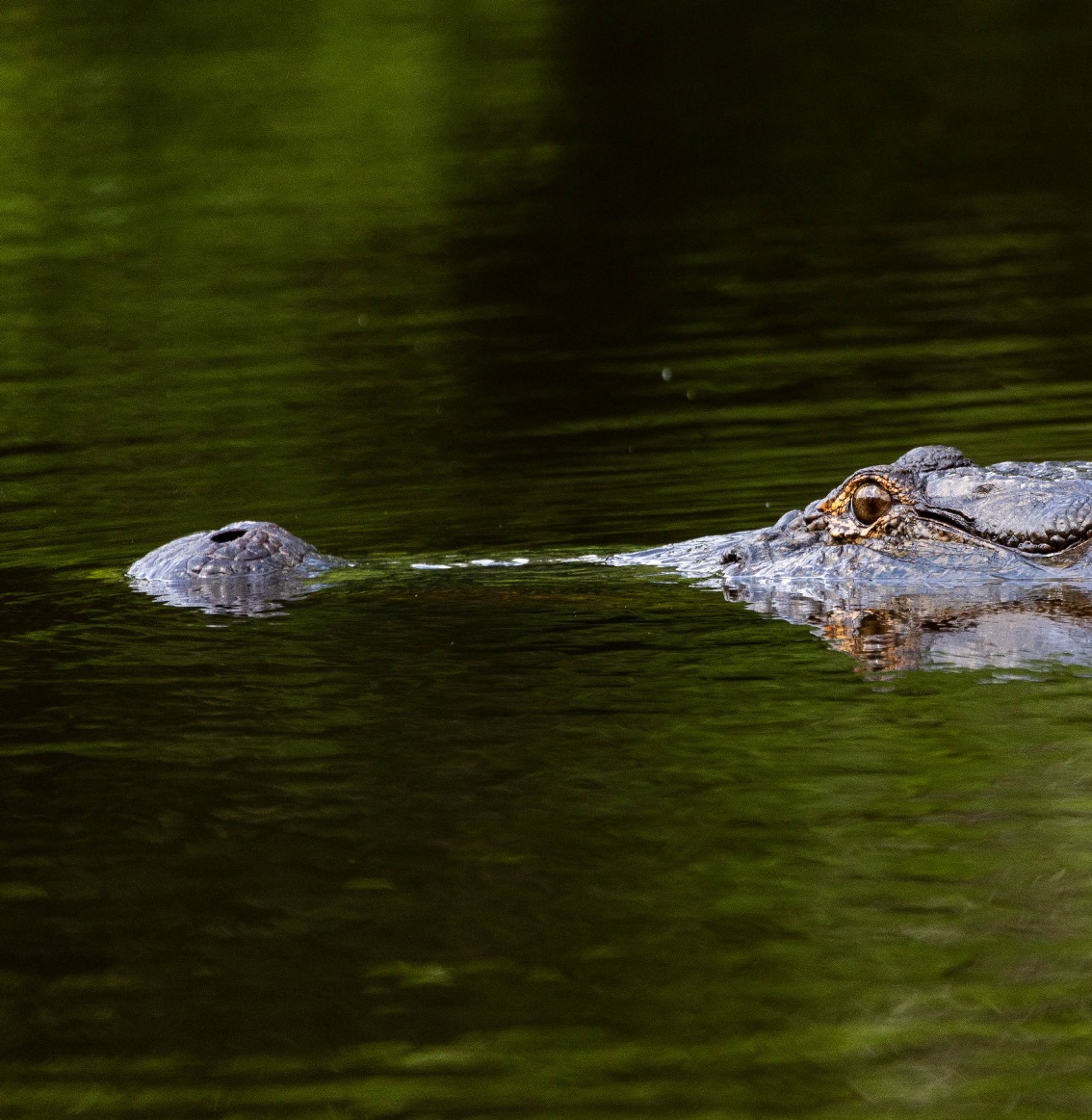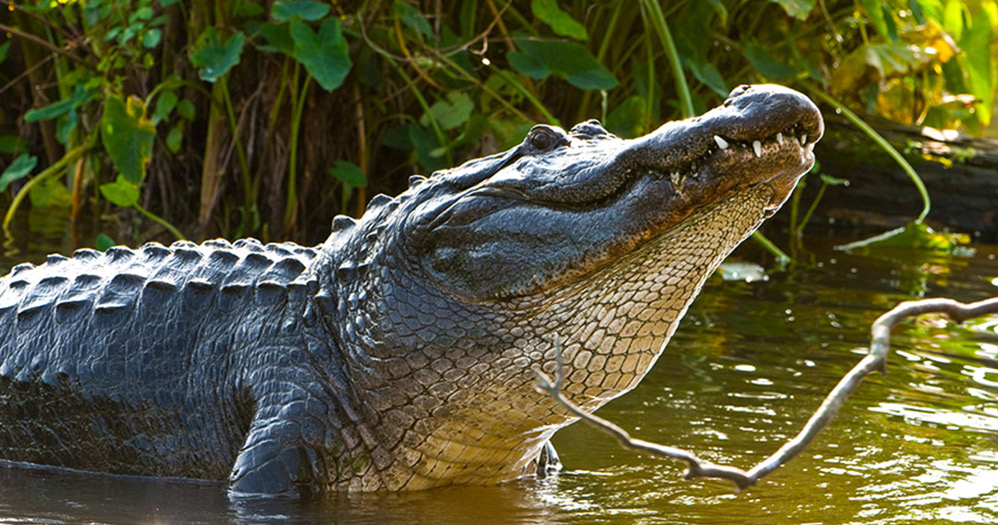
If you have questions about purchasing a license call 1-800-5GO-HUNT.
Learn about the conservation history and recovery of the American alligator in Mississippi, find information about becoming an alligator agent-trapper, and read helpful tips on how to be gator safe.
 Historically, the American alligator was common and abundant throughout the southeastern United States. By 1960, however, alligators had been completely eliminated from much of their former range. The decline in alligator numbers led the U. S. Fish and Wildlife Service, in 1967, to list the American Alligator as an endangered species. Shortly after the 1967 listing, surveys began to indicate that some alligator populations were more secure than was previously thought, and in the early 1970s, alligators were removed from the endangered species list in certain counties and parishes of Louisiana, Florida, and Georgia and listed instead as Threatened by Similarity of Appearance (TS/A).
Historically, the American alligator was common and abundant throughout the southeastern United States. By 1960, however, alligators had been completely eliminated from much of their former range. The decline in alligator numbers led the U. S. Fish and Wildlife Service, in 1967, to list the American Alligator as an endangered species. Shortly after the 1967 listing, surveys began to indicate that some alligator populations were more secure than was previously thought, and in the early 1970s, alligators were removed from the endangered species list in certain counties and parishes of Louisiana, Florida, and Georgia and listed instead as Threatened by Similarity of Appearance (TS/A).
The TS/A designation indicates that the American Alligator is a common and secure species, but that they are similar in appearance to other crocodilians that are very rare and endangered, such as the American Crocodile (found in south Florida) and the Chinese Alligator, which has only a few hundred individuals remaining. Within a few years of receiving endangered species protection, population surveys and increasing numbers of nuisance complaints began to indicate that the alligator populations in Mississippi and across the southeast were rapidly recovering.
On June 4, 1987 the status of the American Alligator was changed to TS/A across the range. This led the Mississippi Legislature, later in 1987, to pass legislation giving the Mississippi Commission on Wildlife Conservation the authority to set regulations to manage alligators. In 1989 the Commission enacted alligator regulations and the Mississippi Department of Wildlife, Fisheries, and Parks (MDWFP) created the Alligator Management and Control Project. The primary objectives of the alligator program are to monitor alligator populations, to control nuisance alligators through the use of alligator agent-trappers, and to educate the public on being safe around alligators.
A common method of surveying alligator populations is to travel along water routes in alligator habitat and count alligator eyeballs, which shine brightly red. MDWFP has been running night-light surveys of alligators along selected routes since 1972. The surveys and the number of nuisance complaints have indicated a steady increase in alligator numbers over the last 30 years.
In 1998, we significantly increased the number of survey routes and the frequency with which they were run so we could develop more proactive and biologically sound management strategies. In 2000, MDWFP conducted 317 miles of alligator surveys along 15 routes in 13 counties, even though several routes could not be run because of low water conditions. From the survey data and satellite imagery used to identify alligator habitat, we have developed a fairly clear picture of the distribution of alligators and alligator habitat in Mississippi.
We recently estimated that there are 32,000-38,000 alligators and about 408,000 acres of alligator habitat in Mississippi. Fourteen northern Mississippi counties have produced no alligator records, but nuisance alligator complaints have come from as far north as Coahoma, Lafayette, and Itawamba Counties. This year's extremely low temperatures could reduce alligator numbers in the northern counties.
Jackson County, with 57,000 acres, has far more alligator habitat than any other county. We estimate that there are about 7,500 alligators in Jackson County, or about 24% of all of the alligators in the state. Other counties with high alligator populations include Hancock, with about 3,900 (12% of state total), and Rankin, with about 2,400 alligators (7.4% of state total). Night-light surveys over the last three years indicate that Rankin County has the highest alligator densities in the state, averaging 7.35 alligators per mile along survey routes, versus an average of 1.76 alligators per mile for the rest of the state. Most of the Rankin County alligator population is located in and around Ross Barnett Reservoir and in the Pearl River to Ratliff Ferry.
 While counting alligators, we also estimate their size. We have discovered that the average size of Mississippi alligators is much larger than alligators sizes reported from other states, such as Florida or Louisiana, where alligators are hunted. Alligators are particularly large in areas where few large nuisance alligators need to be removed: 22% of alligators counted along the Little Sunflower River in Yazoo and Sharkey Counties were greater than 10 feet long, and in Steele Bayou in Issaquena and Washington Counties, 20% of alligators were greater than 10 feet.
While counting alligators, we also estimate their size. We have discovered that the average size of Mississippi alligators is much larger than alligators sizes reported from other states, such as Florida or Louisiana, where alligators are hunted. Alligators are particularly large in areas where few large nuisance alligators need to be removed: 22% of alligators counted along the Little Sunflower River in Yazoo and Sharkey Counties were greater than 10 feet long, and in Steele Bayou in Issaquena and Washington Counties, 20% of alligators were greater than 10 feet.
However, in areas where a great deal of residential and industrial development intrudes into alligator habitat, many alligator/human conflicts result in removal of large alligators and lower average sizes. For example, in Harrison County between the Tchoutacabouffa and Little Biloxi River, only 4.7% of alligators are greater than 10 feet, and in Pelahatchie Bay (Ross Barnett Reservoir), only 4.9% of alligators are greater than 10 feet. Large average sizes of alligators in unhunted populations are largely attributable to the fact that alligators are cannibalistic. One study found that each predator-size alligator eats about 2.5 prey-size alligators per year.
Louisiana harvested about 30,000 alligators last year--a number almost equivalent to the entire Mississippi alligator population. Florida harvested almost as many. Currently harvests of alligators in Mississippi are restricted to nuisance removal by licensed agent-trappers. While the aforementioned population numbers may seem like a lot of alligators, the number that could be harvested yearly on a sustained-yield basis would actually be quite small. The hunt would offer recreational opportunity to only a few hunters, who would probably be chosen by lottery. For these reasons and because a public hunt would be fairly expensive for the Department to administer, it does not appear to be the best alligator management strategy at this time, but we have not completely ruled out the possibility of a limited hunting season at some time in the future.
Agent-trappers do not necessarily need to have previous experience with alligators but should have some experience trapping and handling wild animals. They may not have had Class I wildlife violations or felonies. Agent-trappers are contractors, not employees of MDWFP, and their only compensation is the alligators they harvest. To apply or find out more details about the alligator agent-trapper program, contact the district office in your area, or contact Andrew Arnett.
Endangered species protection and other alligator recovery efforts have been successful in allowing alligators to repopulate areas from which they were previously extirpated. While old-timers may remember that alligators used to be there, many people are beginning to see alligators in places where they have never seen them before, and because they have never seen them before, sometimes they call MDWFP to report a "nuisance" alligator. Sometimes when we respond to these calls, we find an alligator but not a "nuisance" alligator. So what is a nuisance alligator?
If an alligator is in a river, oxbow, swamp, or lake--particularly if they are in public water simply doing what alligators do--that is not a nuisance alligator. If you choose to live in alligator habitat, then alligators are an amenity that often comes with the property. Therefore, an alligator in your backyard is not necessarily a nuisance alligator, especially if your backyard is a marsh. Generally, a nuisance alligator is one that has shown aggressive behavior, one that hangs around seeking handouts, or one that is in a place it has absolutely no business being, such as a swimming pool or garage or in the middle of the highway. We also will remove unwanted alligators from private ponds used for aquaculture or recreation. An alligator that has eaten pets or livestock is generally considered to be a nuisance gator. Usually an MDWFP Conservation Officer confirms that a gator is a nuisance and will dispatch an agent-trapper.
If an alligator is less than eight feet in length, it poses almost no danger to humans unless it is fed or harassed. Even larger alligators are less dangerous to humans than is generally thought if a few safety rules are followed:
Alligators are a natural and important component of aquatic ecosystems in Mississippi, and if you live in or visit these areas, you will probably see them. Observe and enjoy but always follow the alligator safety rules. Visit your MDWFP district office or a state park where alligators are present for a "Be Gator Safe" brochure with more information on being safe around alligators.